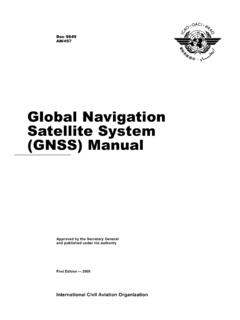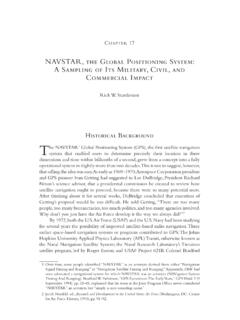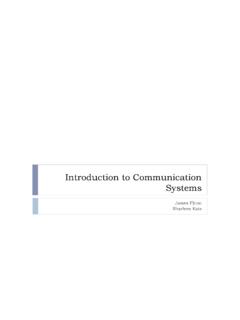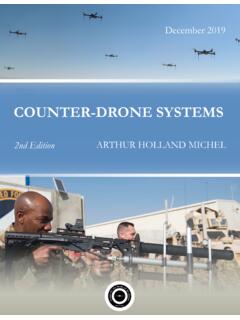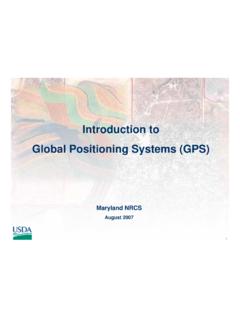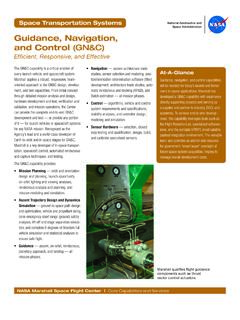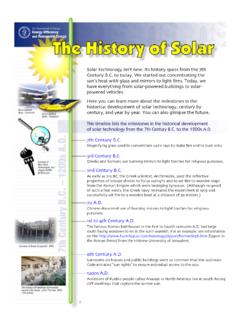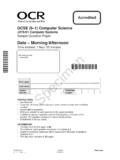Transcription of ICAO Equipment Code Explanations
1 ICAO Equipment Code Explanations Code Name Definition Possible Required Subfield Entry N NIL No COM/NAV approach aid Equipment for the route to be flown is carried, or the Equipment is unserviceable. S Standard Equipment Standard COM/NAV/approach aid Equipment for the route to be flown is carried and serviceable. If the letter S is used, standard Equipment is considered to be VHF RTF,VOR and ILS unless another combination is prescribed by the appropriate ATS authority. S= O+L+V A GBAS landing system Ground-Based Augmentation system (GBAS) is a safety-critical system that augments the GPS Standard Positioning and provides enhanced levels of service. It supports all phases of approach, landing, departure, and surface operations within its area of coverage. B LPV (APV with SBAS) Localizer Performance with Vertical guidance (LPV), Approach with Vertical guidance (APV-SBAS), Space Based Augmentation system (SBAS) The purpose of LPV is to fly ILS look-alike procedures published as RNAV GNSS with LPV minima, by using SBAS.
2 These procedures with vertical guidance constitute a process to approach safety. C LORAN C Long Range navigation (LORAN) C is a terrestrial radio navigation system using low frequency radio transmitters to determine the location and speed of the receiver. D DME Distance Measuring Equipment (DME) is a transponder-based radio navigation technology that measures distance between the Equipment on ground and an aircraft by timing the propagation delay of VHF or UHF radio signals. E1 FMC WPR ACARS Flight Management Computer (FMC) WayPoint Reporting (WPR) Aircraft Communications Addressing Reporting system (ACARS) A number of airlines routinely receive ACARS* position reports from their aircraft via satellite as part of their Airline Operational Control (AOC) flight monitoring.
3 These position reports can be forwarded to an ATS provider and used to replace HF voice position reports. This method of delivery for aircraft position reports is known as FMC WPR. ACARS is a digital datalink system for transmission of short, relatively simple messages between aircraft and ground stations via radio or satellite . REG/(Aircraft Registration Number) DAT/1 PDC E2 D-FIS ACARS Data link (D)-Flight Information Services (FIS) Aircraft Communications Addressing Reporting system (ACARS) The flight information services provided can be weather reports and operational data. ACARS is a digital datalink system for transmission of short, relatively simple messages between aircraft and ground stations via radio or satellite . REG/(Aircraft Registration Number) DAT/1 PDC E3 PDC ACARS Pre-Departure Clearance (PDC) Aircraft Communications Addressing Reporting system (ACARS) Pre-departure clearance from ATC can be received in the cockpit via the ACARS.
4 ACARS is a digital datalink system for transmission of short, relatively simple messages between aircraft and ground stations via radio or satellite . REG/(Aircraft Registration Number) DAT/1 PDC F ADF Automatic Direction Finder (ADF) is a radio- navigation instrument that automatically and continuously displays the relative bearing from the aircraft to a suitable radio station. G GNSS Global navigation satellite system (GNSS) The term GNSS encompasses all the satellite navigation systems such as GPS, GLONASS, GALILEO H HF RTF High Frequency (HF) RadioTelephone (RTF) is mainly used during oceanic flight I INS An Inertial navigation system (INS), Inertial Reference system (IRS) or Inertial Reference Unit (IRU) is a navigation aid that uses a computer, motion sensors (accelerometers) and rotation sensors (gyroscopes) to continuously calculate the position, orientation, and velocity (direction and speed of movement) of a plane without the need for external references.
5 J1 CPDLC ATN VDL Mode 2 Controller Pilot Data Link Communications (CPDLC) Aeronautical Telecommunication Network (ATN) VHF Digital Mode 2 (VDL2) The ICAO VDL Mode 2 is the VDL version most commonly used. The EU Single European Sky rule adopted in January 2009 requires all new aircraft flying in Europe after January 1, 2014 to be equipped with CPDLC. REG/(Aircraft Registration Number) DAT/1 PDC J2 CPDLC FANS 1/A HFDL Controller Pilot Data Link Communications (CPDLC) Future Air navigation Services (FANS) 1/A High Frequency Data Link (HFDL) FANS 1/A provides controller-pilot data link communications (CPDLC) and include air traffic control clearances, pilot requests and position reporting. FANS 1/A typically operates over satellite communications (SATCOM) and is mostly used in Oceanic airspace.
6 FANS 1/A over HFDL provides air traffic control (ATC) communication coverage in the Polar region. REG/(Aircraft Registration Number) DAT/1 PDC J3 CPDLC FANS 1/A VDL Mode A/0 Controller Pilot Data Link Communications (CPDLC Future Air navigation Services (FANS) 1/A VHF Data Link (VDL) Mode A FANS 1/A provides controller-pilot data link communications (CPDLC) and include air traffic control clearances, pilot requests and position reporting. FANS 1/A typically operates over satellite communications (SATCOM) and is mostly used in Oceanic airspace. VDL Mode A is also known as POA (Plain Old ACARS). REG/(Aircraft Registration Number) DAT/1 PDC J4 CPDLC FANS 1/A VDL Mode 2 Controller Pilot Data Link Communications (CPDLC Future Air navigation Services (FANS) 1/A VHF Data Link (VDL) Mode 2 FANS 1/A provides controller-pilot data link communications (CPDLC) and include air traffic control clearances, pilot requests and position reporting.))
7 FANS 1/A typically operates over satellite communications (SATCOM) and is mostly used in Oceanic airspace. The ICAO VDL Mode 2 is the VDL version most commonly used. The EU Single European Sky rule adopted in January 2009 requires all new aircraft flying in Europe after January 1, 2014 to be equipped with CPDLC. REG/(Aircraft Registration Number) DAT/1 PDC J5 CPDLC FANS 1/A SATCOM (INMARSAT) Controller Pilot Data Link Communications (CPDLC) Future Air navigation Services (FANS) 1/A FANS 1/A provides controller-pilot data link communications (CPDLC) and include air traffic control clearances, pilot requests and position reporting. FANS 1/A typically operates over satellite communications and is mostly used in Oceanic airspace. This indicator specifies that the data is transiting via the INMARSAT satellite network.
8 REG/(Aircraft Registration Number) DAT/1 PDC J6 CPDLC FANS 1/A SATCOM (MTSAT) Controller Pilot Data Link Communications (CPDLC) Future Air navigation Services (FANS) 1/A FANS 1/A provides controller-pilot data link communications (CPDLC) and include air traffic control clearances, pilot requests and position reporting. FANS 1/A typically operates over satellite communications and is mostly used in Oceanic airspace. This indicator specifies that the data is transiting via the MTSAT satellite network. REG/(Aircraft Registration Number) DAT/1 PDC J7 CPDLC FANS 1/A SATCOM (Iridium) Controller Pilot Data Link Communications (CPDLC) Future Air navigation Services (FANS) 1/A FANS 1/A provides controller-pilot data link communications (CPDLC) and includes air traffic control clearances, pilot requests and position reporting.
9 FANS 1/A typically operates over satellite communications and is mostly used in Oceanic airspace. This indicator specifies that the data is transiting via the Iridium satellite network. It allows worldwide voice and data communications including the poles, oceans and airways. REG/(Aircraft Registration Number) DAT/1 PDC K MLS Microwave Landing system (MLS) is an aviation approach and landing system providing most accurate and reliable information for safe landings. This system overcomes the possible limitations of the ILS. L ILS Instrument Landing system (ILS) is a ground-based instrument approach system that provides precision guidance to an aircraft approaching and landing on a runway. M1 ATC RTF SATCOM (INMARSAT) Air Traffic Control (ATC) RadioTelephone (RTF) satellite COMmunications (SATCOM) with data transiting via the INMARSAT satellite network REG/(Aircraft Registration Number) DAT/1 PDC M2 ATC RTF (MTSAT) Air Traffic Control (ATC) RadioTelephone (RTF) satellite COMmunications (SATCOM) with data transiting via the MTSAT satellite network REG/(Aircraft Registration Number) DAT/1 PDC M3 ATC RTF (Iridium) Air Traffic Control (ATC) RadioTelephone (RTF) satellite COMmunications (SATCOM) with data transiting via the Iridium satellite network REG/(Aircraft Registration Number) DAT/1 PDC O VOR VHF Omni directional Range (VOR) is a type of radio navigation system for aircraft R PBN approved R indicates the Performance Based navigation (PBN)
10 Levels that can be met and is used by ATC for clearance and routing purposes. The insertion of R in the field 10a requires PBN/ to be present in field 18. The PBN sub-field contains the RNAV and/or RNP certifications and operational approvals applicable for the flight. PBN/ T TACAN Tactical Air navigation (TACAN) is a navigation system in UHF, giving the air crew continuous information as to its range and bearing from a beacon, primarily used by military aircraft. U UHF RTF Ultra High Frequency (UHF) RadioTelephone (RTF) Radio Equipment onboard the aircraft V VHF RTF Very High Frequency (VHF) RadioTelephone (RTF) Radio Equipment onboard the aircraft W RVSM approved Reduced Vertical Separation Minima (RVSM) of 300m (1000ft) separation between aircraft RVSM provides six additional cruising levels between FL 290 and FL 410, resulting in substantial reductions in fuel costs and in-flight delays.










